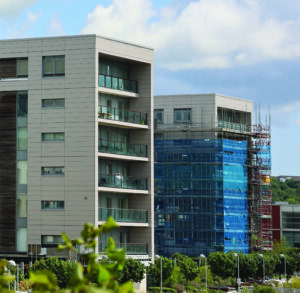
The Grenfell Tower tragedy in 2017 highlighted the paramount importance of safety – particularly fire safety – in the design and installation of building façade systems. Primary fire risks for cladding usually stem from either non-tested combustible materials or inadequate fire breaks. Other risks can arise from incompatible components, including insulation, sheathing boards, fixings or support frames, and poor installation. Since the Grenfell Tower fire, many mid-to-high-rise buildings have been found to have unsafe cladding systems. In many instances, the only viable remedy involves stripping off the cladding and replacing it with improved cladding systems compliant with more suitable safety standards.
Commitment to Safety at Benx
At Benx, safety has consistently been our top priority. With our expertise in fire-protected cladding solutions and continuous investment in testing and certification, we offer one of the most comprehensive ranges of A1 (non-combustible) and A2 (limited combustibility) fire-rated systems for all types of buildings.
Our products and systems are backed by one of the strongest portfolios of certifications and accreditations in the façade industry. Dave Sherlock, Benx Technical Manager, comments, “In addition to BBA and KIWA BDS Agréments, a number of our systems have also been through rigorous CWCT testing to ensure their quality and reliability. These validations provide residents with the confidence that our façade systems have been independently verified and are fit for purpose.”
The Importance of Comprehensive Testing
Our focus is not just on headline fire classifications, but wherever possible, we look at the relationship between the various tests, products, and systems, and how they interact. The UK fire testing regulations for external cladding are governed by the Building Regulations 2010, specifically Approved Document B. This document provides guidance on the minimum standards for fire safety in buildings, including the use of external cladding.
In addition, The Building etc. (Amendment) (England) Regulations 2022 ban the use of combustible materials in the external walls of high-rise residential buildings (over 18 metres) in England, except for certain specified exceptions. Overall, the regulations aim to improve fire safety and prevent a repeat of the tragic Grenfell Tower fire in 2017, where cladding contributed to the rapid spread of the fire.
Moving Forward with Fire Safety in Mind
Fire is at the forefront of all stakeholders’ minds, and rightly so. Ensuring that the materials and systems used in building facades are rigorously tested and compliant with the latest safety standards is crucial for the protection of lives and property. At Benx, we are committed to leading the industry in fire safety, providing peace of mind for residents and building owners alike.
By continually advancing our fire safety measures and maintaining our dedication to high standards, we aim to contribute to safer buildings and a safer future.
